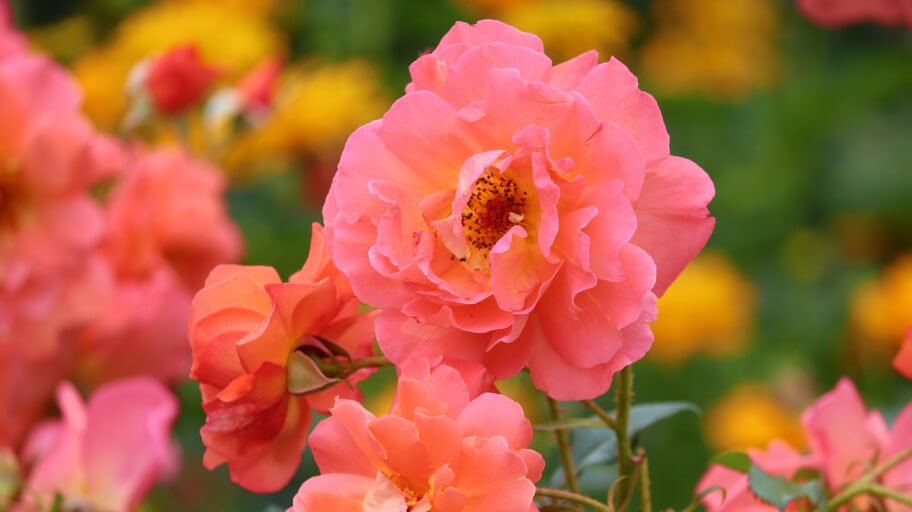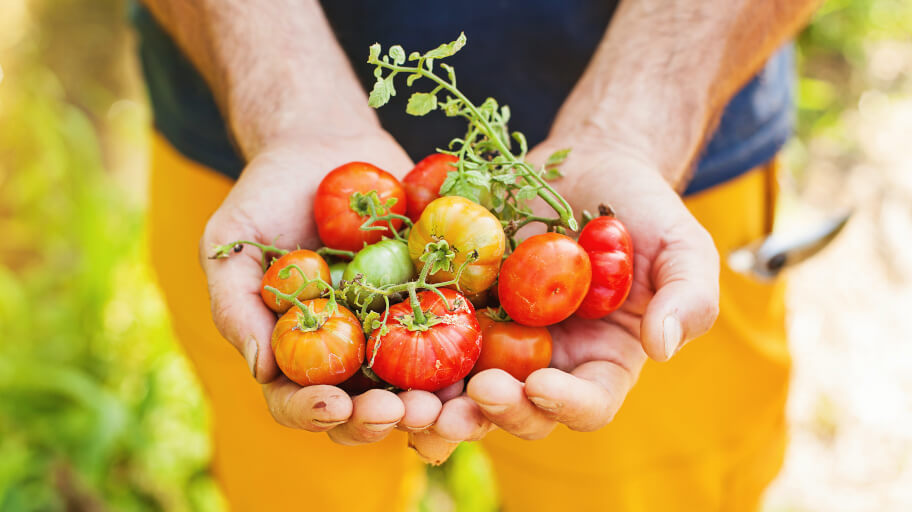
Turmeric, also known as Curcuma Longa, is an exotic plant that originally comes from India, but nowadays it’s also cultivated in other tropical parts of Asia. The yellow powder that we know comes from the root of the plant and it has many purposes – medical, culinary and beauty related. The plant itself is popular, as well, because of its beautiful flowers and tropical appearance.
So whenever you need turmeric to add an exotic look to your garden or you want to take advantage of its many unique usages, the professionals at Fantastic Gardeners present to you this handy guide on how to take care of this plant.
Turmeric plant’s characteristics
Turmeric is the main name of this flowering plant, however all around the world, it’s also called Indian Saffron, Curcuma, Curcumin, and similar. It belongs to the ginger family Zingiberaceae and is able to reach around 1 metre in height with rhizomes below the ground. The beautiful white flower spikes that it grows are the reason why so many people choose to have Turmeric in their gardens even if they don’t need it for anything else.
However, in order to grow properly, the Curcuma needs soil with good drainage, a tropical climate with no frosts and lots of water. If you decide to have Turmeric, you will need to plant it in nice, fertile soil that doesn’t get waterlogged and keep it in light shade.
Curcuma is mostly used in Asian cuisines for adding colour to food. It also has a very specific, mustardy, bitter flavour and aroma that is perfect to spice up various dishes.
Even if there isn’t much hard scientific evidence, a lot of people strongly believe in the medical properties of the plant. It’s said that it has amazing anti-inflammatory properties and can help in relieving a number of serious diseases, such as arthritis, symptoms of depression, bad cholesterol and many more.
How to grow turmeric
Similar to ginger, growing Turmeric requires rhizomes. You can find them in most organic, bio food stores, in garden centres or just look for it online. Make sure that the root is not already dried otherwise nothing will happen.
When to plant the turmeric?
The best time to plant your turmeric will be in early spring like September or at the beginning of October.
How to plant?
- Place the rhizomes in pairs, at least 5cm deep into warm soil. Spreading fertiliser over the soil is optional, but it can help grow healthy plants.
- If you want multiple plants, place the buds around 15 to 30 cm apart from each other.
- Water the area
If you live in a cooler region of Australia, we recommend that you plant the Turmeric in a glass greenhouse or grow it in pots inside your home. The same principles apply for planting, however, pay attention to the kind of pot you are using and the quality of the soil. It is best if you grow your turmeric in a pot that is approximately 300mm deep and 300-400mm wide to provide enough space for the plant to develop.
As Curcuma is a herbaceous perennial, if you want to replant it, cut clumps of the plant and use the fresh pieces when it’s time to do it.
Turmeric plant care
Once planted, it is essential to provide the turmeric with the right kind of care, so it can develop strong. Here is what to do.
Position
As we’ve mentioned, Turmeric thrives in warm, moist weather, so find a place where it’s going to be properly sheltered from the find. However, you also have to make sure that you grow the spice in light shade, as the plant will not be very happy if it’s left under direct sunlight during the whole day.
Soil
Ensure that the soil has good drainage and is also rich in nutrients.
Water
Throughout the whole growing season, the plant must be kept moist, so you should water it frequently, especially if you live in a warm, dry region.
You can also spray the foliage with water just to keep the leaves moist and prevent them from drying.
Temperature
The minimum temperature Turmeric can endure is 10 C but the perfect range that we recommend is from 20 to 35 C.
Overwintering
In order for your Turmeric to survive during the winter, you will need to water less frequently than you would normally do. At some point, when the temperature starts to drop, the leaves will turn yellow and begin to wilt.
What you need to do it is to cut the plant to the level of the soil and leave it there to hibernate. When the spring comes and the weather is warmer, it will begin to grow again.
If you live in a cooler zone, somewhere within or outside zone 7, you will need to dig the roots from the ground, otherwise, they will probably freeze.
Rinse the dirt from them and get rid of any rotten parts. Leave the rhizomes to dry and store them someplace inside until spring comes.
Fertilizer
Regularly apply compost or manure to the soil just to keep it rich in nutrients. You can also either use a specific fertilizer that is just for turmeric or purchase a multi-purpose product.
Pruning
Thankfully, there is no need to prune the plant at all. The only thing you have to do is to get rid of the dried leaves.
Pests and diseases
Usually, Curcuma is not a plant that can be affected by most pests or typical diseases. However, if it does get sick, the symptoms can be rhizome rot or spots appearing on the leaves. The rotting normally occurs when there is a water-logging problem with the soil, which is why we’ve mentioned the importance of good drainage.
With regards to any possible pest issues, look out for scales and red spider mites.
Harvesting turmeric
So, if you have planted Turmeric, in order to use its yellow powder, you should know how to harvest it properly. You will know it’s time to harvest the turmeric with the first signs of maturity. These include yellow leaves and the stems falling off or drying. This usually happens around 8 to 10 months after planting.
You can either dig up the whole plant along with the rhizomes or just carefully cut off only the roots you will need. Save up some of the turmeric plants if you want to replant them for the new season.
So, now that you have all the roots that you need, this is how to make the turmeric powder:
- Put on some gloves to protect your skin from getting stained. Turmeric is a really potent dye and it’s extremely difficult to wash off.
- Boil the roots for at least 45 minutes. They need to become soft, in order for the end product to taste better and have a stronger colour.
- Leave them to dry just a little once they are done boiling.
- Peel the skin of the rhizomes and cut each of them into two pieces.
- Leave the roots to dry for at least a week. They need to be completely dry without a single drop of water inside.
- Grind the pieces in a blender or with a pounder until they turn into a fine powder.
- Put the turmeric powder in a glass jar with a tight-fitting lid.
- Store the jar someplace away from direct sunlight.
Turmeric uses and benefits
There are many people throughout the world that trust the medical capabilities of Turmeric. Because of those properties and many more, Curcuma Longa is also known as “Super Food”.
It’s mostly used in alternative medicine and in cooking, of course. However, it’s important to note that all of these supposed superpowers are caused by a compound in Turmeric, called Curcumin. The active ingredient is more effective when combined with black pepper because of the piperine that it contains.
So, if you are wondering if it’s worth taking care of this plant and the long process of making the powder, here is a short list of the most popular uses of Turmeric:
1. Uses of Curcuma in cooking:
- The turmeric powder is widely used as a food dye because of its strong yellow pigments. Actually, 25% of the components in curry powder consist of Turmeric.
- In Indonesia, people eat the root tips and the young shoots raw.
- The leaves are often used to wrap fish when cooking, in order to give it a specific flavour
2. Medical uses of Turmeric:
- A strong painkiller that can help even in cases of burnt skin.
- It helps reduce severe inflammation, especially if people suffer from rheumatoid arthritis.
- The same anti-inflammatory properties are shown when dealing with bowel disease, Crohn’s disease and many other gastrointestinal problems.
- When people use prescription drugs to treat those issues, there are many painful side effects, which do not occur during treatment with Turmeric.
- It’s said to help in reversing insulin resistance and in lowering high blood sugar, so it’s naturally recommended for people with type 2 diabetes.
- Improves short and long-term memory, as well as cognitive function.
Takeaways
- Growing Turmeric is not a hard job as long as you do it at the right time and temperature.
- Even if you don’t believe in the medical uses of Curcumin, the beautiful flowers and exotic look of the plant should be a good enough reason for you to give it a chance.
- Turmeric powder is actually quite expensive on the market, so if you are one to use it frequently, growing the plant and making the powder yourself is surely the cheaper way to go.








